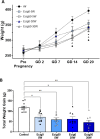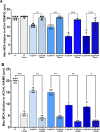Pregnancy and Postpartum Effects of Electronic Cigarettes on Maternal Health and Vascular Function in the Fourth Trimester
- PMID: 39841346
- PMCID: PMC11885370
- DOI: 10.1007/s12012-025-09961-x
Pregnancy and Postpartum Effects of Electronic Cigarettes on Maternal Health and Vascular Function in the Fourth Trimester
Abstract
Pregnancy is a vulnerable time with significant cardiovascular changes that can lead to adverse outcomes, which can extend into the postpartum window. Exposure to emissions from electronic cigarettes (Ecig), commonly known as "vaping," has an adverse impact on cardiovascular function during pregnancy and post-natal life of offspring, but the postpartum effects on maternal health are poorly understood. We used a Sprague Dawley rat model, where pregnant dams are exposed to Ecigs between gestational day (GD)2-GD21 to examine postpartum consequences. Litter and dam health were monitored during the weaning period, and maternal vascular and endocrine function were assessed after weaning. Exposure to Ecig emissions during pregnancy led to fetal losses (i.e., reabsorption in utero) and reduced survival of pups during weaning compared to controls (air-exposed dams). We find that maternal vaping during pregnancy, with or without nicotine (or flavoring) results in maternal vascular and hormonal dysfunction (i.e., reduced prolactin, increased expression of sirtuin 1 deacetylase in the brain). Both 5 and 30W Ecig aerosol exposures resulted in significant impairment of middle cerebral artery reactivity to acetylcholine-mediated dilation (decreasing ~ 22 and ~ 50%, respectively). We also observed an increase in the number of extracellular vesicles (EVs) in plasma from 30-W group that persists up to 3-week postpartum and that these EVs impaired endothelial cell function when applied to in vitro and ex vivo assays. Our data suggest (1) Ecig vaping, even without nicotine or flavorings, during pregnancy alters maternal circulating factors that influence maternal and fetal health, (2) circulating EVs may contribute to the etiology of vascular dysfunction, and (3) that the window for recovery from vascular dysfunction in the dam is likely to be longer than the exposure window.
Keywords: Brain; Middle cerebral artery; Myography; Pregnancy; Vaping.
© 2025. The Author(s).
Conflict of interest statement
Declarations. Conflict of interest: The authors declare no competing interests.
Figures







Similar articles
-
Influence of gestational window on offspring vascular health in rodents with in utero exposure to electronic cigarettes.J Physiol. 2024 Sep;602(17):4271-4289. doi: 10.1113/JP286493. Epub 2024 Aug 6. J Physiol. 2024. PMID: 39106241
-
Maternal use of electronic cigarettes and impact on offspring: a double-hit model.J Appl Physiol (1985). 2024 Sep 1;137(3):690-704. doi: 10.1152/japplphysiol.00345.2024. Epub 2024 Aug 1. J Appl Physiol (1985). 2024. PMID: 39088647
-
Long-term cerebrovascular dysfunction in the offspring from maternal electronic cigarette use during pregnancy.Am J Physiol Heart Circ Physiol. 2021 Aug 1;321(2):H339-H352. doi: 10.1152/ajpheart.00206.2021. Epub 2021 Jun 25. Am J Physiol Heart Circ Physiol. 2021. PMID: 34170194 Free PMC article.
-
Vaping versus Smoking: A Quest for Efficacy and Safety of E-cigarette.Curr Drug Saf. 2018;13(2):92-101. doi: 10.2174/1574886313666180227110556. Curr Drug Saf. 2018. PMID: 29485005 Review.
-
Electronic nicotine delivery systems and pregnancy: Recent research on perceptions, cessation, and toxicant delivery.Birth Defects Res. 2019 Oct 15;111(17):1284-1293. doi: 10.1002/bdr2.1561. Epub 2019 Jul 31. Birth Defects Res. 2019. PMID: 31364280 Free PMC article. Review.
References
-
- Lewey, J., Beckie, T. M., Brown, H. L., Brown, S. D., Garovic, V. D., Khan, S. S., Miller, E. C., Sharma, G., Mehta, L. S., Disease, o.b.o.t.A.H.A.C., Women, S.i., Cardiology, U.P.C.o.t.C.o.C., Council on Cardiopulmonary, C.C., Perioperative, Resuscitation, Cardiovascular, C.o. and Nursing, S. (2024). Opportunities in the postpartum period to reduce cardiovascular disease risk after adverse pregnancy outcomes: A scientific statement from the American heart association. Circulation,149, e330–e346. - PMC - PubMed
-
- Baba, S., Wikström, A.-K., Stephansson, O., & Cnattingius, S. (2014). Influence of snuff and smoking habits in early pregnancy on risks for stillbirth and early neonatal mortality. Nicotine & Tobacco Research,16, 78–83. - PubMed
MeSH terms
Substances
Grants and funding
LinkOut - more resources
Full Text Sources
Medical

